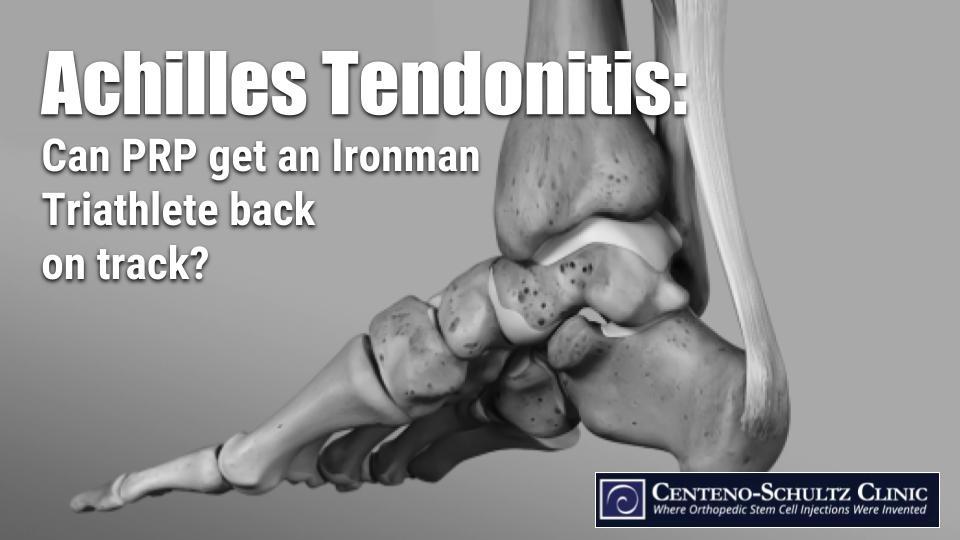Achilles tendon problems can significantly limit your activity level, and this can be particularly concerning if you are a high-level athlete. Missing out on training due to an injury can be not only physically draining but also mentally draining. One such example is of an Achilles tendinitis was in a seven-time Ironman triathlete patient of ours. His tendon hadn’t yet torn, but it was in bad shape, and his surgeon actually suggested they wait for it to tear and then repair it. Fortunately, he didn’t take this advice and came to see us instead where we were able to treat his Achilles tendinitis with an ultra-high dose of his own platelet-rich plasma (PRP). More on that in a moment; first, let’s take a look at the Achilles tendon.
Understanding the Achilles Tendon and Its Injuries
This Achilles tendon can be felt starting at the back on the ankle, starting at the heel and reaching up to where it connects at the calf muscle. It’s unmistakable as it’s a thick and solid tendon that feels a bit like an industrial-strength rubber band; in fact, you can feel it stretch and compress as you move your foot up and down, or stretch out your calf muscle. Just the simple motion of walking keeps this tendon constantly engaged and in motion. Throw in athletics or other activities and the Achilles tendon is put under a major amount of stress.
While the Achilles tendon is very strong, when it becomes overworked, injuries can occur. These include tendinitits or tendinopathy and tears. Tears come in many forms, including partial; complete nonretracted, which is a tear in which the tendon is torn but still holding together; and full Achilles ruptures, or a full tear where the tendon has actually snapped back with no remaining fibers holding it together. For tears, surgery, as was mentioned above was suggested by our patient’s surgeon, to stitch the tendon back together is often the recommended. Unfortunately, Achilles tendon tear surgeries are associated with many problems, such as high failure rates and other complications, lengthy recovery times (something an athlete doesn’t typically have time for), and some studies have even shown that surgery is no more effective than immobilizing the ankle for a few weeks.
While there are regenerative medicine solutions for tears, our patient made his way to us before his got that far. Let’s review Randall’s Achilles tendonitis.
Triathlete’s Achilles Tendinitis Addressed Without Surgery
When we first saw Randall, a high-level Ironman triathlete, in addition to his Achilles tendinitis and an ankle problem, he also had a bad back and a bum knee. While these are all different areas of the body, all of his issues from his back to his ankle were related. His Achilles issue resulted from tight calf and ankle muscles, which resulted from poor knee control due to a nerve issue in his low back. So Randall had a lot of issues that needed to be addressed. We started with his back.
Using platelet-based therapies isolated from Randall’s own platelets, we injected the area around the irritated nerves in his low back. Once he’d achieved 80% improvement, we then focused on the loose ligaments in his knee, injecting under precise guidance here as well. Finally, we injected a lower dose of PRP into the back of his heel. With only partial relief in his moth-eaten-appearing and hypertrophied Achilles tendon, we knew his Achilles tendinitis would need more.
Because we utilize our state-of-the-art lab, which can customize treatments based on patient need, instead of using the standard one-size-fits-all bedside machine to concentrate cells and platelets, we were able to provide an ultra-high-dose PRP to treat Randall’s Achilles tendonitis. At his last visit, Randall reported that he was not only 100% improved, but that he’d just completed his seventh Ironman—biking, running, and swimming without any Achilles issues. His ultrasound supported his report, as the Achilles tendon now has a normal appearance.
In more severe cases, our high-dose PRP may not be enough, but thanks to our inhouse lab, we can produce an ultra-high-dose PRP using the your own platelets. It certainly did the trick for this seven-time Ironman triathlete!

